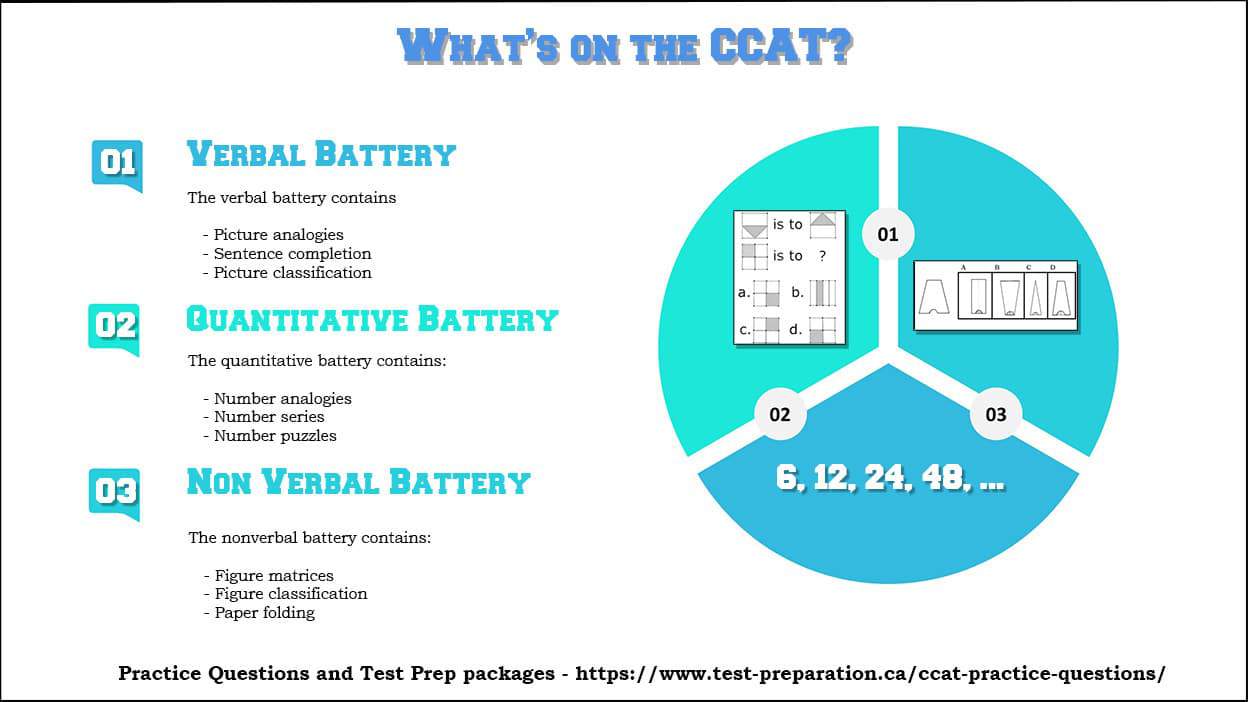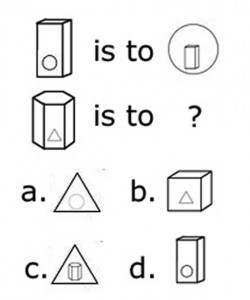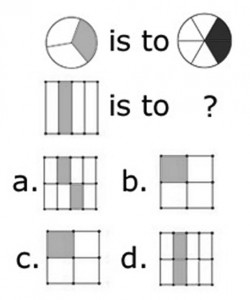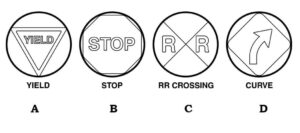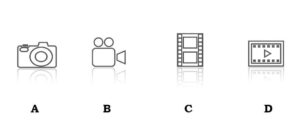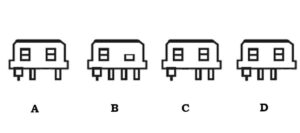About the CCAT Grade 4 Test
Canadian schools use the CCAT 4th grade test to determine children’s cognitive abilities in grade 4. This test is commonly known as CCAT Level 10 as the children who take the test are expected to be around 10 years of age. Widely taken by school-going children, the test analyzes children’s learning aptitude and is one of the requirements for joining a gifted and talented program. The CCAT Level 10 is different from normal 4th-grade school tests. The structure is different, and the questions are mostly outside the school curriculum. The test focuses on measuring one’s ability to handle complex situations by reasoning.
At 10 years of age, CCAT Level 10 test-takers have acquired an advanced cognitive abilities, especially verbal skills. Students answer questions from three sections, the quantitative battery, the verbal battery, and the nonverbal battery.
Click here for CCAT Grade 4 Practice and Test Package
CCAT Grade 4 Test Sections
Students must answer 176 questions on the CCAT Level 10 test. This test is structured as other CCAT tests, with three sections. Each section uses in-depth questions on each topic to measure a candidate’s verbal, quantitative, and non-verbal abilities.
Verbal Battery
The Verbal Battery of the CCAT (Canadian Cognitive Abilities Test) measures a student’s ability to understand and reason with concepts framed in words. This includes skills like verbal reasoning, vocabulary, analogies, and sentence completion. These questions test relationships between words, identifying patterns, and applying logic.
Verbal Analogies
1. Nest : Bird Cave :: _____
a. bear
b. petal
c. house
d. dog
Answer: A
A Bird lives in a nest, the way way a bear lives in a cave.
2. Teacher : School :: _____ : _____
a. Businessman : Money
b. Waitress : Coffee Shop
c. Dentist : Tooth
d. Fish : Water
Answer: B
A teacher works in a school in the same way a Waitress works in a coffee shop.
3. Pebble : Boulder :: Pond : _____
a. Ocean
b. River
c. Drop
d. Rapids
Answer: A
A boulder is a very large pebble – both are rocks, in the same way an ocean is a very large pond – both are very bodies of water.
Vocabulary
Example Questions
1. What is a “polygon”?
A) A three-dimensional shape
B) A figure with multiple angles and sides
C) A type of line segment
D) A type of angle
Answer: B
A polygon is a flat shape with at least three straight sides and angles, such as a triangle or square.
2. What does the word “represent” mean?
A) To take away something
B) To stand for or symbolize something
C) To oppose something
D) To create something new
Answer: B
“Represent” means to act or speak on behalf of someone or something, or to be a symbol of something.
3. What does it mean to “predict” something?
A) To guess without any information
B) To remember something from the past
C) To say what will happen in the future based on information
D) To change an outcome
Answer: C
“Predict” means to make an educated guess about what will happen in the future based on current knowledge or evidence.
Sentence Completion
1. The meeting was __________ because it determined the company’s future.
A) sparse
B) peculiar
C) crucial
Answer: C) crucial
The word “crucial” means extremely important or decisive. Since the meeting determined the company’s future, it was important or “crucial” to its success.
2. In the desert, vegetation is often __________ due to the lack of water.
A) crucial
B) peculiar
C) sparse
Answer: C) sparse
The word “sparse” means thinly scattered or in small amounts. Vegetation in the desert is typically limited because of the arid environment, making “sparse” the correct choice.
3. Her behavior was __________ at the party, and many people found it hard to understand.
A) crucial
B) sparse
C) peculiar
Answer: C) peculiar
“Peculiar” refers to something that is strange or unusual. Since her behavior was difficult for others to comprehend, it can be described as “peculiar.”
Practice Questions (Vocabulary Style – meaning in Context)
Grades 2 – 3 Sentence Completion – (Audio)
CCAT Grade 4 Practice and Test Package
Nonverbal Battery
The Nonverbal Battery presents the test taker with geometric shapes and figures, and asks them to identify relationships between pictures in a matrix, determine how a shape will look when folded or unfolded, and recognizing patterns in a set of shapes and choosing the next figure in the sequence.
Figure Classification
Test-takers are presented with three shapes lined up together. To answer, test-takers must select a fourth shape that matches the category of the three shapes.
Directions: In each of the following questions, select the choice that does not belong with the other three.
1.
2.
3.
1. When the two longest sides touch what will the shape be?
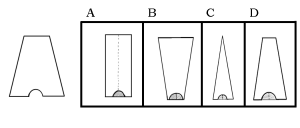
Answer: D
2. When folded into a loop, what will the strip of paper look like?
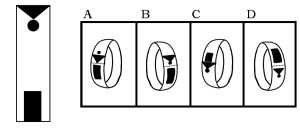
Answer: A
Folding Practice – Visual Acuity
Number Series
Test-takers are given a series of numbers that follow a predetermined rule. They must choose a final number from the choices to complete the series.
1. Consider the following series: 6, 12, 24, 48. What number should come next?
a. 48
b. 64
c. 60
d. 96
Answer: D
The numbers double each time.
2. Consider the following series: 5, 6, 11, 17. What number should come next?
a. 28
b. 34
c. 36
d. 27
Answer: A
Each number is the sum of the previous two numbers.
3. Consider the following series: 26, 21, …, 11, 6. What is the missing number?
a. 27
b. 23
c. 16
d. 29
Answer: C
The numbers decrease by 5 each time.
Quantitative Battery
Number Puzzles
Test-takers are presented with a mathematical equation with a missing number. The equation will be solved by selecting a number that fits the gap and completes the equation.
Example Questions
1. 2 + ___ = 9
a. 7
b. 3
c. 6
d. 8
Answer: A
1. 2 + 7 = 9
2. (3 X 4) – 5 = ___
a. 17
b. 7
c. 12
d. 15
Answer: B
(3 X 4) – 5 = 7
3. (8 X 2) X (2 X 3) ___
a. 60
b. 72
c. 96
d. 92
Answer: B
(8 X 2) X (2 X 3) = 72
Number Analogies
Test-takers are given a pair of numbers and must decide the relationship between the numbers. They are then presented with another number missing its pair. Test takers must apply the relationship from the first pair to complete the second pair.
Example Questions
1. 1 is to 2 as 3 is to:
a) 4
b) 5
c) 6
d) 7
Answer: a)
Just as 1 increases by 1 to become 2, 3 increases by 1 to become 4.
2. 2 is to 4 as 3 is to:
a) 5
b) 6
c) 7
d) 8
Answer: b)
Just as 2 is doubled to become 4, 3 doubled is 6.
3. 5 is to 10 as 6 is to:
a) 11
b) 12
c) 13
d) 14
Answer: b)
Just as 5 is doubled to become 10, 6 doubled is 12.
CCAT Grade 4 Practice and Test Package
CCAT Grade 4 Test Score
How to Read CCAT 4th Grade’s Test Score Report
The CCAT level 10 result slip has three scores that summarize the general cognitive ability of each student. Each score is reached at by summing the results of the quantitative, nonverbal, and verbal sections. Each report will have an Age Percentile Rank (APR) score that ranks all candidates in a specific age group, a Grade Percentile Rank (GPR) that compares students according to other candidates in their grade, and a Stanine (S) score.
A stanine score shows every student’s learning aptitude on a scale from 1 to 9, with 9 being the highest possible score, 5 being average, and 1 being the lowest. APR ranks 10-year-old candidates within their own age group.
CCAT 4th Grade Tips
Familiarize with the time limits.
Simulated CCAT Level 4 practice tests can be very useful familiarizing students with time limits. Many practice tests will have a timer to update you on how much time is left to finish the test. The actual test has time limits for every section. Practice ensures students are comfortable answering the questions at the required pace.
Make the study time fun.
At 10 years of age, most children prefer playing outside to sitting in a room studying. To effectively prepare for the test, let your child think of study time as a game and not a task. This will make your child anticipate the study sessions and not think of it as a task to complete before going out to play.
How to prepare for the CCAT Grade 4 Test
- Start preparations a month before the scheduled test day. Allowing a child to have enough time to go through and familiarize themselves with the material will increase their chances of doing well in the test. Try to practice with your child regularly for a few hours so they learn gradually without feeling pressured or stressed. Avoid waiting until the last minute to rush your child through the material.
- To familiarize your child with the concept of time, use a timer in your practice. Each section of the test has a time limit. Ensure that your child understands they cannot take all the time on one question or section. Having regular timed tests is very important if you are dealing with a slow test taker.
- Go through the explanation of each question in detail. Make sure students go through the answer explanations, even when they answer the questions correctly. Explanations can provide important insights into the questions and answers.
CCAT Grade 4 Practice and Test Package
Date Published: Thursday, April 14th, 2022
Date Modified: Thursday, February 27th, 2025

